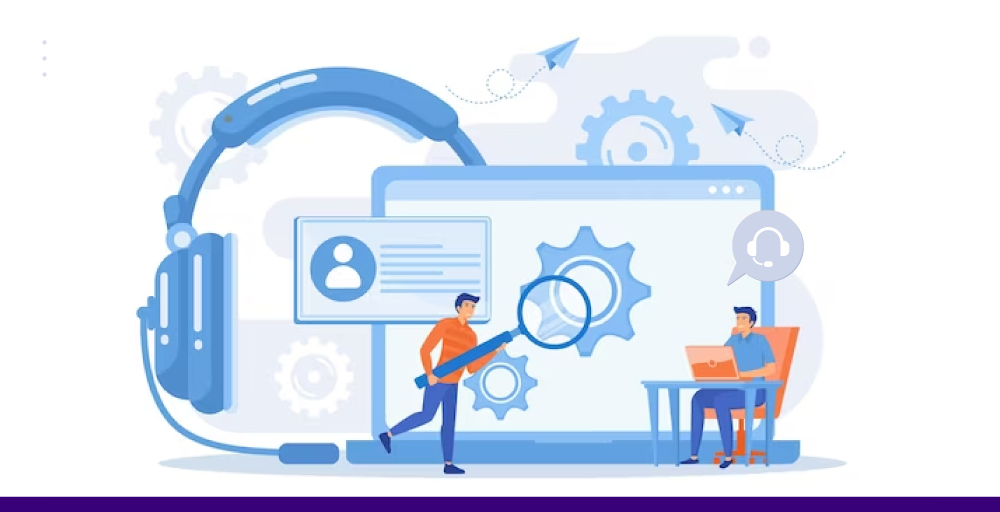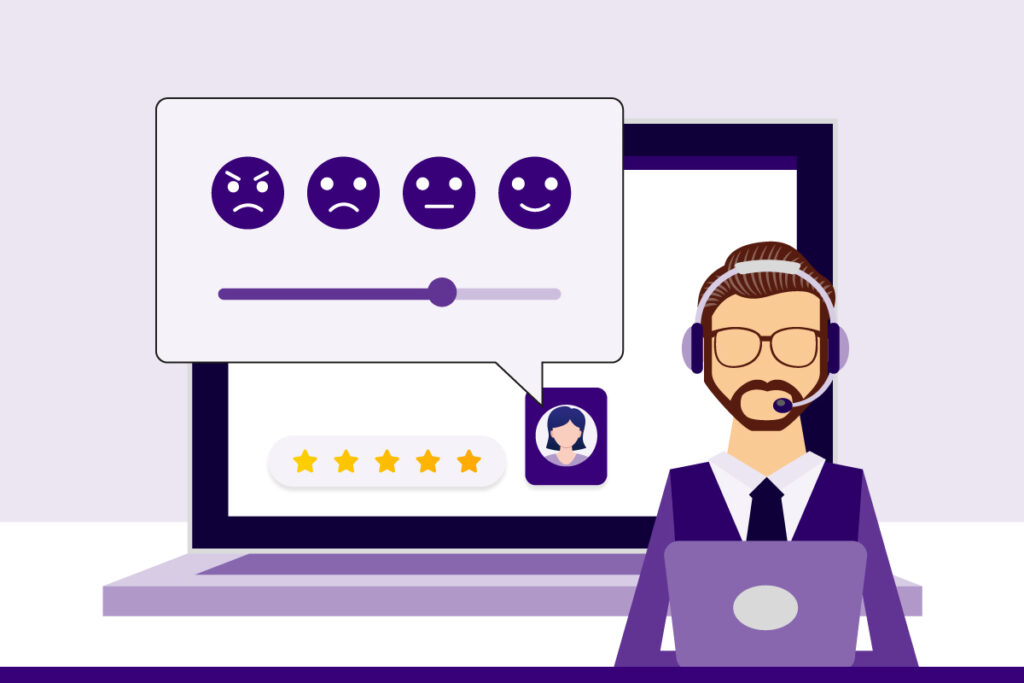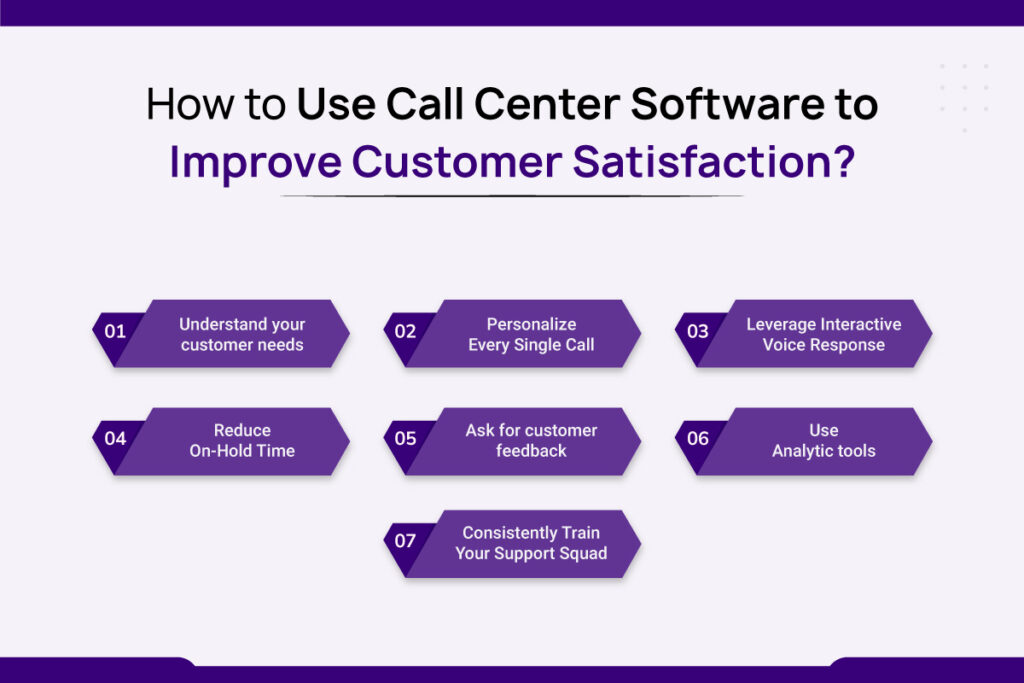
Are you struggling with managing customer interactions and facing problems meeting their rising expectations? If so, you’re not alone.
To tackle all those problems, we have call center software. In this article, you will learn about the use of call center software and how to use it to improve your customer satisfaction effectively.
So let’s get started.
What is Customer Satisfaction?

Customer satisfaction refers to the degree of fulfilment, contentment, or happiness that a customer experiences after interacting with a product, service, or brand. It measures how well the provided products or services meet or exceed customer expectations.
High customer satisfaction indicates positive customer experiences, and businesses often use it as a key performance indicator. This helps to gauge the success of a company’s offerings and build long-term customer loyalty. Customer satisfaction is commonly assessed through surveys, feedback forms, and other means to understand and improve the overall customer experience.
Why is Call Center Software Important to Improve Customer Satisfaction?
Call center software is essential for improving customer satisfaction and simplifying communication procedures so that they are closer and more interpersonal.
Several call center solutions often come with a lot of features, such as call routing, IVR, call data, call history, virtual receptionists, and many more.
Likewise, if your business deals with international customers, Call center software also provides virtual phone numbers. This helps customers to call from anywhere, as virtual numbers are not confined to geolocation. Just get a USA virtual phone number, and you can call USA from anywhere. This gives customers a feeling of trust and confidence to do business if they see a local number.
This mixture of features helps call center agents deliver better service faster and more efficiently. Call center software can also help call centers measure and improve their performance by giving them analytics.
Take, for example, if analytics shows that customers frequently mention a problem, then the company can take targeted steps to solve it as soon as possible, preventing its recurrence in future customer experiences.
What are the Factors that Affect Customer Satisfaction?
Managing Numerous Calls Simultaneously
Managing a lot of calls at the same time can really affect customer satisfaction. That can contribute to long waits and difficulties in answering customer queries, which anger customers. Prolonged wait time tells customers their time is not valued, impacting the company’s image.
Also, the concurrent juggling of multiple calls can affect the quality of customer interaction. Representatives may lack the time needed to give personal attention and solutions, making customers feel undervalued.
Building great relationships requires effective communication and understanding of customer needs, but if call center agents have to rush through too many calls or chats in an hour, trust breaks down fast. Correctly handling call volume is essential to providing just-in-time, personalized support that leaves a favorable impression.Delay in Addressing Customer Concerns
A quick resolution of complaints has a great effect on customer satisfaction. To maintain the impression and keep relations intact, issues must be quickly addressed. Failing to resolve concerns in a timely manner can lead to greater frustration and dissatisfaction, while those who do get around quickly are seen as being more committed and efficient.
Moreover, these delays can turn minor matters into major ones. The public expects quick, effective responses; long-standing doubts can become exaggerated and cause more serious inconvenience.
The longer it takes to resolve problems, the more customers may feel that a company is unconcerned or uncaring. This will undoubtedly affect overall satisfaction levels negatively. Reducing delays in solving worries is vital to creating loyalty and a good customer experience.Call Quality and Clarity Issues
Unclear speech and broken connections make communication difficult, contributing to misunderstandings. As a result, these problems lead to frustration and dissatisfaction for customers who cannot communicate their wants or understand the information offered. Any difficulty in sound quality reflects poorly on the perceived competency and dependability with which to handle your business.
Moreover, call quality problems can affect the perception that a company cares about its customers. When customers phone a company to talk with its representatives, they expect them to be of at least adequate technical proficiency and reliability.
If call quality is a persistent problem, it could be that the owner has not invested enough in infrastructure or neglects customer communications needs. But that, too, can eat away at trust and confidence in the company’s ability to deliver a satisfactory experience. Consequently, call quality and clarity are key issues in customer relations.Showing Rude Behavior Towards Customers
Rude actions affect satisfaction by violating the expectation of being treated with respect. This kind of attitude toward the customer makes them feel devalued in person or online. Overall, their experience and loyalty suffer as a result.
Worse still, bad behavior can cause negative word of mouth and social media reviews, damaging the company’s image. In this global village, these experiences spread to a wider audience almost immediately, suppressing business.
An atmosphere of courteous customer service is necessary to maintain and improve customer satisfaction. In today’s integrated world, it affects not only personal contacts but also the image and success of the overall business.
How to Use Call Center Software to Improve Customer Satisfaction?

Understand Your Customer Needs
To take the most out of call center software, use it to know your customers and their needs better. By utilizing call center software like KrispCall which offers advanced functions for recording and monitoring calls, reviewing customer conversations to find patterns and preferences, analyzing call reports regularly, and many more.
Through features such as customer relationship management (CRM), you can centralize and organize all customer information and preferences. Information such as previous contacts, sales history, and specific preferences expressed by the customer will all be included in this centralized hub. This multitude of information means that agents can offer personalized service.
As an entrepreneur, you can keep track of real-time reports, KPIs, and service levels to better understand your customer needs and offer them the best quality all year. It also shows the company’s respect and care towards each customer as an individual. Combining all these functions turns call center software into a powerful means of understanding and serving customers.Personalize Every Single Call
To improve customer satisfaction, personalizing every call with the contents of their software is important. The first thing to do is quickly integrate customer relationship management tools (CRM) into the call center – so that whenever you dial in, there’s access right at your fingertips.
CRM involves past contacts, buying history, and details of their preferences or specific needs as indicated by them. The agents also know customers’ names when they last called in and can make their responses according to individual needs. Through this kind of customization, the company shows its concern for the customer and builds a greater relationship with them.
This minimizes the amount of information customers need to repeat while resolving issues and demonstrates a dedication to efficiency as well as personalized service. Today’s call center software combines CRM integration with intelligent routing, creating a highly focused tool for personalizing calls so as to greatly enhance satisfaction and loyalty.Leverage Interactive Voice Response (IVR)
Implementing IVR in your contact centers can certainly improve customer satisfaction and increase operational efficiency by smoothing the process for customers. By creating a user-friendly IVR that provides convenient menu choices with clear and natural prompts, you can shorten the time customers spend searching through menus.
Also, you can use IVR to collect customer information before transferring the call. By gathering such information as account numbers and what the caller wants to discuss, agents are able to determine how to approach each call. Not only is this convenient for the call in progress, but it also conveys a desire to be efficient, ultimately affecting customer satisfaction.Reduce On-Hold Time
With the use of call center software features such as intelligent call routing and forwarding, calls can be answered as soon as possible. Outbound calls are sent to the most suitable agents based on skills and workload, with no need for call transfers improving query resolution speed.
Also, call center software allows you to request callbacks automatically so that customers do not need to wait on hold. This would save them time and make their lives easier in some small way.
Furthermore, you can use the call center software’s monitoring tools to see when calls are at their busiest accordingly. With this proactive attitude, demands are met while on-hold times can be reduced at busy periods.Ask for Customer Feedback
Call center software can be used to gather customer feedback, which, if handled efficiently and properly, will help increase satisfaction. These software often come with automatic post-call surveys or prompt alerts as part of the system so that you can collect feedback easily.
Ask your customers a few targeted questions like the ease of resolving problems with agents, their impression of agent professionalism, or their satisfaction with the product. However, make sure to make these surveys quick and simple so that your customers won’t feel irritated. Most customers enjoy giving feedback, so don’t forget to thank them for their time and attention.
With these types of feedback mechanisms in place, you can then utilize the analysis provided by your call center software. Discover trends and actionable insights by means of digital sentiment analysis software that pinpoints the tone of customer reviews. For example, it is extremely useful when training agents, revising the script, and even making adjustments in procedures.Use Analytic Tools
Using the analytic tools included in most call center software can do a lot to boost customer satisfaction. The first step is to introduce capabilities for collecting, storing, and analysing customer interaction data. Such tools can also help understand customer habits, tastes, and pain points.
This is where customer call recordings, sentiment analysis, and the user journey can all come together. We can then look for trends and patterns and points at which improvements need to be made.
In addition, you can take advantage of real-time analysis to continuously observe and analyze the performance of call center personnel. Establish key performance indicators (KPIs) to monitor such metrics as average handling time, first-call resolution rate, and customer satisfaction. In this way, by using analytic tools in the call center, you can make improvements according to trend analysis.Consistently Train Your Support Squad
You can use call center software features for training and monitoring to ensure customer support representatives are well-equipped to handle inquiries. Regular training sessions and performance evaluations contribute to a knowledgeable and efficient support team, positively impacting customer satisfaction.
You can effectively use call center software to continuously train and monitor your service team, bringing customer satisfaction up a notch. Some of the call center software also provides training functions in order to hold frequent and focused training courses.
You can use call recording and monitoring capabilities to evaluate skills like real-time interaction. This helps to identify the places where there are shortcomings and helps while giving training accordingly.
Conclusion
In conclusion, call center software is a great solution to managing your overall communication and improving customer satisfaction. You can take this article as a reference on the ability of those software and how to use them to boost your business.
You can’t make an omelette without breaking a few eggs. Just the same, improving your customer service may require reshuffling settled patterns of behavior. So, don’t stick with the old traditional telephone lines; choose call center software for smooth and convenient customer interactions.
FAQS
1. How can call center software improve customer satisfaction?
Call center software streamlines customer interactions, enhances agent efficiency, and provides valuable insights through analytics, ultimately leading to quicker issue resolution and improved customer satisfaction.
2. Which method can be used to improve customer service?
Implementing a robust customer feedback system enables businesses to gather insights directly from customers, identify pain points, and make informed improvements to enhance overall service quality.
3. What are the 3 ways of providing better customer service?
The 3 ways of providing better customer service are as follows:
- Prompt Response: Respond to customer inquiries and issues quickly.
- Personalization: Tailor interactions to individual customer needs and preferences.
- Continuous Improvement: Regularly assess and enhance processes based on customer feedback and changing needs.
4. Which tool is most useful in customer service?
A Customer Relationship Management (CRM) tool is often considered the most useful in customer service. This is because it centralizes customer information, interactions, and history, enabling businesses to deliver more personalized and effective customer service.